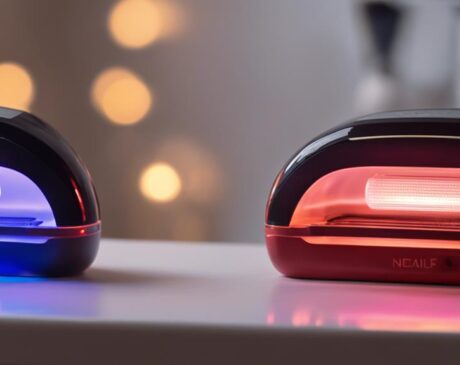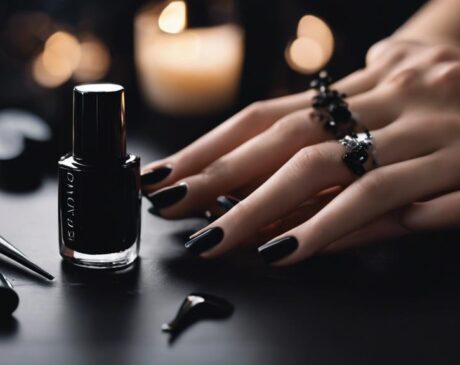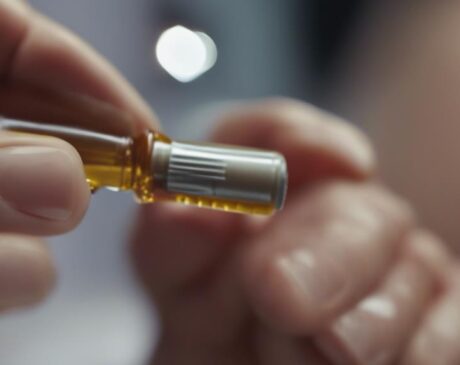Can You Overcure Nails?
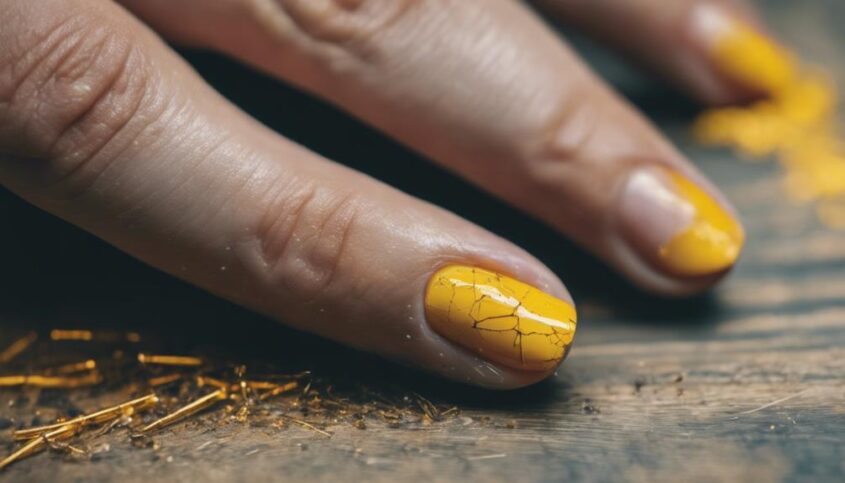
Overcuring nails can have detrimental effects, causing dryness, brittleness, and skin irritation. This can result in peeling, splitting, and other issues compromising nail health. Proper curing techniques, using the correct lamps, and monitoring product application are essential to prevent overcuring. Maintaining even light distribution and avoiding overexposure during curing are crucial for healthy nails. Additionally, following tips for healthy nails and balancing style with nail health can improve overall nail condition. Understanding the risks of overcuring is vital for optimal nail care and appearance.
Key Takeaways
- Overcuring nails can lead to dryness, brittleness, and damage.
- Signs include brittle, discolored, and thin nails.
- Overcuring dehydrates nails, causing sensitivity and discomfort.
- Prevent overcuring by following proper curing times and techniques.
- Use correct lamps and monitor product application to avoid overcuring risks.
The Dangers of Overcuring Nails
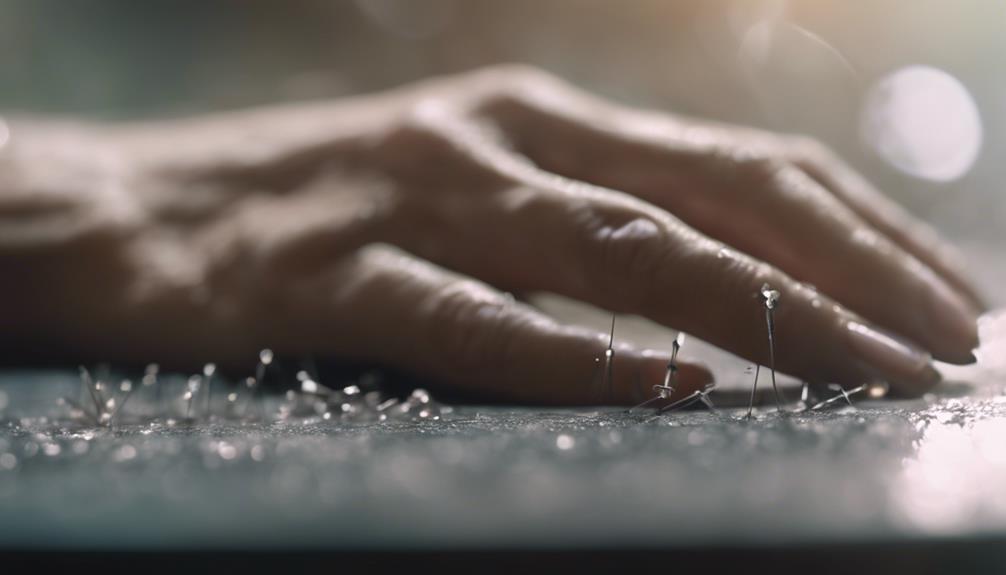
Overcuring nails in the context of nail care can lead to adverse consequences for both the nail plate and surrounding skin. When nails are overcured, they become excessively dry and brittle, increasing the risk of breakage and damage. This can compromise the overall health and appearance of the nails, making them more prone to issues such as peeling, splitting, and cracking.
Additionally, overcuring nails can also have a negative impact on the surrounding skin. The harsh chemicals and excessive heat used in the curing process can cause irritation, redness, and dryness to the skin around the nails. In more severe cases, overcuring can even lead to chemical burns or allergic reactions, further highlighting the importance of proper nail care techniques.
To mitigate these risks, it is essential to strike a balance in nail curing processes, ensuring that nails are adequately cured without overexposure to damaging factors. By staying mindful of the curing times and techniques used, individuals can maintain healthy, vibrant nails while safeguarding the well-being of their skin.
Signs of Overcured Nails
Excessive curing of nails can manifest through various observable indicators that signal potential overcuring effects on nail health and appearance. When nails are overcured, there are clear signs that can help identify this issue:
- Brittleness: Overcured nails may become overly brittle, leading to easy breakage and peeling.
- Discoloration: Nails that have been overcured might exhibit discoloration, appearing yellowish or unusually dark.
- Dryness: Overcuring can strip the nails of their natural oils, causing them to become excessively dry and prone to cracking.
- Thinness: Over time, overcured nails may become thinner and weaker, losing their natural resilience.
These visible signs indicate that the nails have been subjected to excessive curing, potentially compromising their health and aesthetics. Monitoring these indicators can help individuals take proactive steps to prevent overcuring and maintain the overall well-being of their nails.
Impact on Nail Health
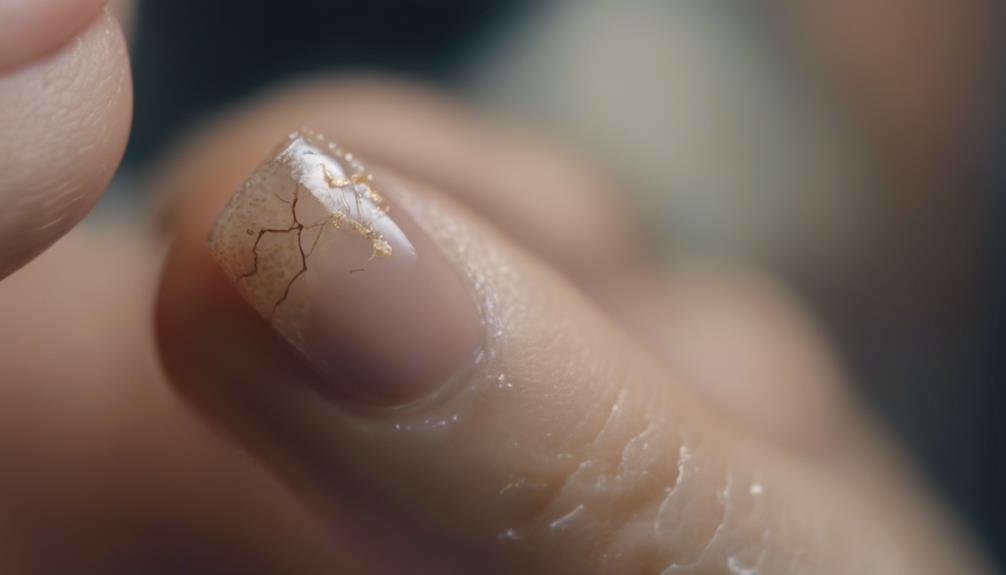
The prolonged exposure to intense curing processes can significantly impact the overall health of nails. Overcuring nails can lead to various detrimental effects on nail health. Excessive exposure to UV or LED light during curing can result in nail dehydration, causing them to become dry, brittle, and prone to breakage. Moreover, overcuring can lead to the thinning of the nail plate, making it more susceptible to damage and infections. The excessive heat generated during overcuring processes can also cause discomfort and sensitivity in the nail bed.
Furthermore, overcuring may disrupt the natural balance of oils and moisture in the nails, leading to issues such as peeling, splitting, or discoloration. These effects not only compromise the aesthetic appearance of nails but also pose risks to overall nail health. It is crucial to be mindful of proper curing techniques and durations to maintain the health and integrity of nails.
How to Prevent Overcuring
To prevent overcuring nails, it is essential to adhere to the proper curing time recommended for the specific nail product being used. Additionally, using the correct lamp that is compatible with the product is crucial to avoid overcuring. Monitoring the application of the nail product to ensure a thin, even layer can also help prevent overcuring and promote healthier nails.
Proper Curing Time
Properly timing the curing process is essential in ensuring the longevity and quality of nail enhancements. To prevent overcuring, consider the following:
- Follow Manufacturer Guidelines: Always adhere to the recommended curing times provided by the product manufacturer.
- Use a Timer: Invest in a timer to accurately track the curing time and avoid overexposure.
- Avoid Multi-Curing: Refrain from curing layers for longer than necessary or curing multiple times unnecessarily.
- Monitor Product Reactivity: Be mindful of how different products react to curing times and adjust accordingly for optimal results.
Use Correct Lamp
Selecting the appropriate lamp for curing nails is crucial in preventing overcuring and ensuring optimal results in nail enhancements. LED lamps are popular for their quick curing times and energy efficiency, making them a preferred choice for many nail technicians. These lamps are designed to cure gel polishes effectively without causing overcuring issues. UV lamps, on the other hand, emit a broader spectrum of light and can cure a wider range of products. However, it's essential to ensure the UV lamp used is compatible with the specific nail products being applied to prevent overcuring. By using the correct lamp for the nail enhancement products being used, technicians can deliver flawless results while avoiding the risk of overcuring.
Monitor Product Application
Effective monitoring of product application during the nail enhancement process is essential to prevent overcuring and ensure the longevity of the manicure. To achieve optimal results, consider the following innovative techniques:
- Consistent Thickness: Ensure an even thickness of product application to promote uniform curing.
- Proper Coverage: Cover the entire nail surface adequately to prevent undercuring and overcuring spots.
- Avoiding Product Runoff: Prevent excess product from pooling at the sidewalls and cuticles, which can lead to overcuring.
- Proper Layering: Apply product in thin layers, curing each one properly, to prevent overcuring due to excessive thickness.
Proper Curing Techniques
When it comes to proper curing techniques for nails, it's crucial to pay attention to the curing time as it directly impacts the final result. Ensuring even light distribution during the curing process is essential for achieving a uniform and long-lasting finish. Additionally, it's important to avoid overexposure to the curing light to prevent any potential damage or overcuring of the nails.
Curing Time Importance
A critical factor in achieving long-lasting and durable nail enhancements is ensuring the proper curing time during the application process. To ensure optimal results, consider the following innovative techniques:
- Use a high-quality LED or UV lamp designed for nail curing.
- Follow the manufacturer's recommended curing times for each layer of product applied.
- Avoid rushing the curing process to prevent undercuring, which can lead to product lifting or chipping.
- Experiment with different curing times based on the product viscosity and layer thickness for the best outcome.
Even Light Distribution
Maintaining uniform light distribution during the curing process is paramount for achieving optimal results in nail enhancements. Properly curing nail enhancements requires even exposure to UV or LED light to ensure thorough polymerization of the products used. Uneven light distribution can lead to inconsistent curing, resulting in soft or sticky nails that are prone to premature chipping or lifting. To achieve even light distribution, practitioners can use techniques such as rotating the client's hand during curing or utilizing lamps with strategically placed bulbs to ensure all areas receive adequate exposure. By prioritizing uniform light distribution, nail technicians can enhance the durability and longevity of their nail enhancements, providing clients with impeccable results.
Avoid Overexposure
To ensure optimal results in nail enhancements, it is crucial to implement proper curing techniques that prioritize avoiding overexposure to UV or LED light. When curing nails, consider the following innovative practices:
- Use the Recommended Time: Follow the manufacturer's guidelines for curing times to prevent overexposure.
- Maintain Proper Distance: Position the nails correctly under the light to ensure even curing without excessive exposure.
- Invest in Quality Equipment: High-quality lamps can provide efficient curing with minimal exposure time.
- Rotate Hand Position: Adjust the angle of the hand during curing to expose all areas evenly, reducing the risk of overexposure.
Tips for Healthy Nails
Ensuring the health of your nails involves consistent care and attention to detail. To maintain healthy nails, consider incorporating these innovative tips into your nail care routine. Firstly, keep your nails well-hydrated by using a nourishing cuticle oil or cream regularly. Hydration is key to preventing brittle nails and promoting flexibility. Secondly, practice good nail hygiene by keeping your nails clean and dry to prevent bacterial or fungal infections. Use a gentle nail brush to clean under the nails and trim them straight across to avoid ingrown nails. Additionally, protect your nails from damage by wearing gloves while doing household chores or gardening. When using nail polish, opt for formulas that are free from harmful chemicals like formaldehyde, toluene, and DBP. Lastly, maintain a balanced diet rich in vitamins and minerals to promote overall nail health. By following these tips, you can achieve strong, healthy nails that are both beautiful and resilient.
Balancing Style and Nail Health
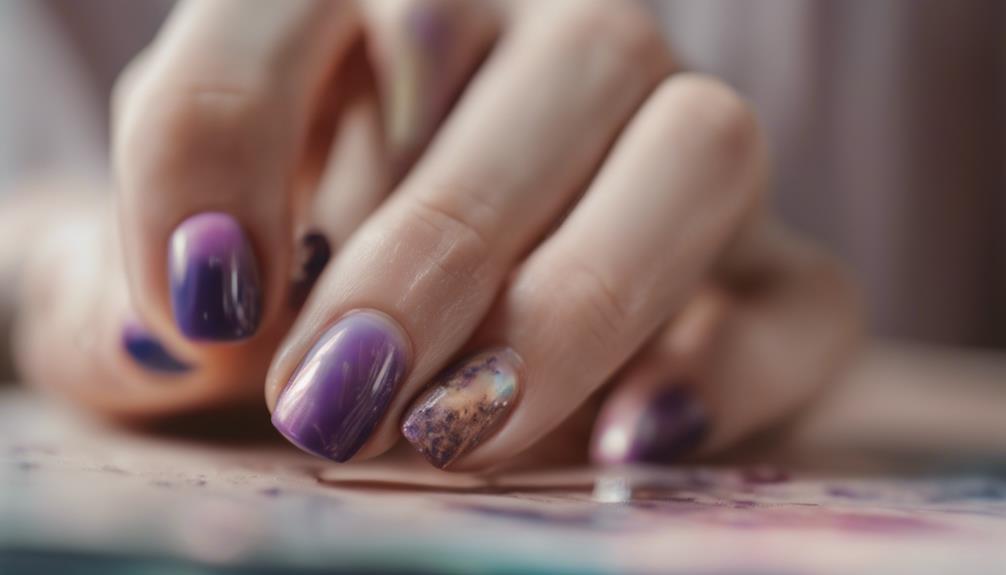
Achieving stylish nail designs while prioritizing nail health requires a delicate balance of care and creativity. When it comes to balancing style and nail health, innovation is key. Here are four innovative tips to help you achieve stunning nail designs without compromising the health of your nails:
- Hybrid Nail Polish: Utilize hybrid nail polish that combines the long-lasting properties of gel polish with the easy application and removal of traditional polish.
- Nail Strengthening Treatments: Incorporate nail strengthening treatments into your nail care routine to keep your nails healthy and strong, even when adorned with stylish designs.
- Breathable Nail Products: Opt for breathable nail products that allow air and moisture to reach the nail bed, promoting overall nail health.
- Nail Art Alternatives: Explore nail art alternatives such as nail wraps or press-on designs that offer intricate styles without the need for excessive filing or chemical exposure.
Frequently Asked Questions
Can Overcuring Nails Lead to Long-Term Damage or Health Issues?
Overcuring nails can potentially lead to long-term damage or health issues. It is crucial to follow recommended curing times and avoid prolonged exposure to UV or LED light to maintain nail health and integrity.
Are Certain Types of Nail Products More Likely to Cause Overcuring?
When considering nail products, one should assess the formulations for potential overcuring risks. Certain types of products, especially those with higher concentrations of curing agents, may increase the likelihood of overcuring, affecting nail health long-term.
Can Overcuring Nails Affect the Appearance or Longevity of Nail Polish?
Overcuring nails can indeed affect the appearance and longevity of nail polish. Excessive exposure to UV/LED light can lead to premature fading, discoloration, or peeling of nail polish. It's crucial to follow proper curing times to maintain optimal results.
How Can I Tell if My Nails Have Been Overcured Without Professional Assistance?
To discern overcured nails without professional aid, look for signs such as increased heat during curing, a strong chemical odor, or nails feeling excessively hard. Monitoring the curing process and using recommended times can prevent overcuring.
Are There Any Alternative Methods for Curing Nails That Reduce the Risk of Overcuring?
Alternative methods for curing nails that reduce the risk of overcuring include using LED lamps with preset timers, low heat lamps, and proper application techniques to ensure even curing. These innovations aim to enhance efficiency and safety in nail care practices.

